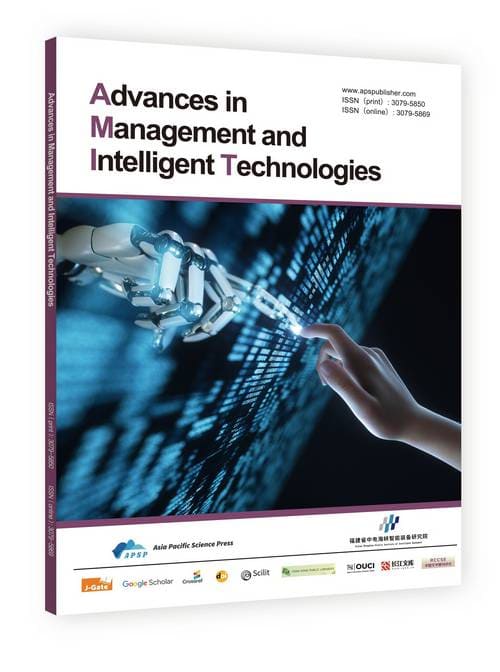Coupling Relationship Between Land Use Changes and Surface Thermal Environment in China's Three Major Urban Agglomerations
DOI:
https://doi.org/10.62177/amit.v1i4.518Keywords:
Three Major Urban Agglomerations, Surface Thermal Environment, Land Use Change, Urban Heat Island EffectAbstract
This study focuses on China's three major urban agglomerations—Beijing-Tianjin-Hebei, the Yangtze River Delta, and the Pearl River Delta. Based on a review of literature data, it examines the spatial and temporal patterns of urban and agricultural land use changes from 2005 to 2024, as well as their impacts on the surface heat environment. The results show that urban land has continued to expand significantly across all three regions, while agricultural land has declined sharply. As a result, the urban heat island effect has become increasingly severe. Urban land contributes much more to surface temperature rise compared to agricultural land. There are clear differences among the three city clusters in terms of land use structure and the evolution of their heat environments. The main driving forces behind these differences include rapid urbanization, industrial restructuring, population growth, and the lack of effective land use planning. This study provides theoretical support for better understanding the coupling relationship between urban land use and the ecological environment system. It also offers useful insights into urban land management and strategies to mitigate heat-related environmental impacts.
Downloads
References
Awuah, K. G. B., & Abdulai, R. T. (2022). Urban Land and Development Management in a Challenged Developing World: An Overview of New Reflections. Land, 11(1), 129. https://doi.org/10.3390/land11010129 DOI: https://doi.org/10.3390/land11010129
Chang, Y., Zhang, G., Zhang, T., Xie, Z., & Wang, J. (2020). Vegetation Dynamics and Their Response to the Urbanization of the Beijing–Tianjin–Hebei Region, China. Sustainability, 12(20), 8550. https://doi.org/10.3390/su12208550 DOI: https://doi.org/10.3390/su12208550
Chen, B., Huang, Z., He, W., & Wang, M. (2024). Comprehensive Land Consolidation as a Development Strategy for Rural Revitalization: The Political Ecology Mechanisms and Benefits of the Pastoral Complex. Land, 13(6), 897. https://doi.org/10.3390/land13060897 DOI: https://doi.org/10.3390/land13060897
Chen, Y., Yang, J., Yang, R., Xiao, X., & Xia, J. (2022). Contribution of urban functional zones to the spatial distribution of urban thermal environment. Building and Environment, 216, 109000. https://doi.org/10.1016/j.buildenv.2022.109000 DOI: https://doi.org/10.1016/j.buildenv.2022.109000
Deng, J. S., Wang, K., Hong, Y., & Qi, J. G. (2009). Spatio-temporal dynamics and evolution of land use change and landscape pattern in response to rapid urbanization. Landscape and Urban Planning, 92(3-4), 187–198. https://doi.org/10.1016/j.landurbplan.2009.05.001 DOI: https://doi.org/10.1016/j.landurbplan.2009.05.001
Frederic Deng, F., & Huang, Y. (2004). Uneven land reform and urban sprawl in China: the case of Beijing. Progress in Planning, 61(3), 211–236. https://doi.org/10.1016/j.progress.2003.10.004 DOI: https://doi.org/10.1016/j.progress.2003.10.004
Fu, H., Zhao, S., & Liao, C. (2022). Spatial governance of Beijing-Tianjin-Hebei urban agglomeration towards low-carbon transition. China Agricultural Economic Review, 14(4), 774–798. https://doi.org/10.1108/caer-04-2022-0069 DOI: https://doi.org/10.1108/CAER-04-2022-0069
Gao, J., Gong, J., Yang, J., Li, J., & Li, S. (2022). Measuring Spatial Connectivity between patches of the heat source and sink (SCSS): A new index to quantify the heterogeneity impacts of landscape patterns on land surface temperature. Landscape and Urban Planning, 217, 104260. https://doi.org/10.1016/j.landurbplan.2021.104260 DOI: https://doi.org/10.1016/j.landurbplan.2021.104260
Ge, K., Zou, S., Lu, X., Ke, S., Chen, D., & Liu, Z. (2022). Dynamic Evolution and the Mechanism behind the Coupling Coordination Relationship between Industrial Integration and Urban Land-Use Efficiency: A Case Study of the Yangtze River Economic Zone in China. Land, 11(2), 261. https://doi.org/10.3390/land11020261 DOI: https://doi.org/10.3390/land11020261
Guo, A., Yue, W., Yang, J., Li, M., Xie, P., He, T., Zhang, M., & Yu, H. (2023). Quantifying the impact of urban ventilation corridors on thermal environment in Chinese megacities. Ecological Indicators, 156, 111072. https://doi.org/10.1016/j.ecolind.2023.111072 DOI: https://doi.org/10.1016/j.ecolind.2023.111072
He, Q., Zeng, C., Xie, P., Tan, S., & Wu, J. (2019). Comparison of urban growth patterns and changes between three urban agglomerations in China and three metropolises in the USA from 1995 to 2015. Sustainable Cities and Society, 50, 101649. https://doi.org/10.1016/j.scs.2019.101649 DOI: https://doi.org/10.1016/j.scs.2019.101649
He, Y., Pu, N., Zhang, X., Wu, C., & Tang, W. (2025). Long-Term Spatiotemporal Heterogeneity and Influencing Factors of Remotely Sensed Regional Heat Island Effect in the Central Yunnan Urban Agglomeration. Land, 14(2), 232–232. https://doi.org/10.3390/land14020232 DOI: https://doi.org/10.3390/land14020232
Hesse, M. (2016). The City as a Terminal: The Urban Context of Logistics and Freight Transport (1st ed.). Routledge. https://doi.org/10.4324/9781315614748 DOI: https://doi.org/10.4324/9781315614748
Hesslerová, P., Pokorný, J., Huryna, H., & Harper, D. (2019). Wetlands and Forests Regulate Climate via Evapotranspiration. Ecological Studies, 238, 63–93. https://doi.org/10.1007/978-3-030-14861-4_4 https://doi.org/10.7524/AJE.1673-5897.20191010001 DOI: https://doi.org/10.1007/978-3-030-14861-4_4
Hu, Y., Xu, E., Kim, G., Liu, C., & Tian, G. (2021). Response of Spatio-Temporal Differentiation Characteristics of Habitat Quality to Land Surface Temperature in a Fast Urbanized City. Forests, 12(12), 1668. https://doi.org/10.3390/f12121668 DOI: https://doi.org/10.3390/f12121668
Huang, K., Li, X., Liu, X., & Seto, K. C. (2019). Projecting global urban land expansion and heat island intensification through 2050. Environmental Research Letters, 14(11), 114037. https://doi.org/10.1088/1748-9326/ab4b71 DOI: https://doi.org/10.1088/1748-9326/ab4b71
Li, W., Han, C., Li, W., Zhou, W., & Han, L. (2020). Multi-scale effects of urban agglomeration on thermal environment: A case of the Yangtze River Delta Megaregion, China. Science of the Total Environment, 713, 136556. https://doi.org/10.1016/j.scitotenv.2020.136556 DOI: https://doi.org/10.1016/j.scitotenv.2020.136556
Li, Y. ying, Liu, Y., Ranagalage, M., Zhang, H., & Zhou, R. (2020). Examining Land Use/Land Cover Change and the Summertime Surface Urban Heat Island Effect in Fast-Growing Greater Hefei, China: Implications for Sustainable Land Development. ISPRS International Journal of Geo-Information, 9(10), 568. https://doi.org/10.3390/ijgi9100568 DOI: https://doi.org/10.3390/ijgi9100568
Li, Z., Sun, Z., Tian, Y., Zhong, J., & Yang, W. (2019). Impact of Land Use/Cover Change on Yangtze River Delta Urban Agglomeration Ecosystem Services Value: Temporal-Spatial Patterns and Cold/Hot Spots Ecosystem Services Value Change Brought by Urbanization. International Journal of Environmental Research and Public Health, 16(1), 123. https://doi.org/10.3390/ijerph16010123 DOI: https://doi.org/10.3390/ijerph16010123
Liou, Y.-A., & Kar, S. (2014). Evapotranspiration Estimation with Remote Sensing and Various Surface Energy Balance Algorithms—A Review. Energies, 7(5), 2821–2849. https://doi.org/10.3390/en7052821 DOI: https://doi.org/10.3390/en7052821
Liu, H., Zheng, H., Wu, L., Deng, Y., Chen, J., & Zhang, J. (2024). Spatiotemporal Evolution in the Thermal Environment and Impact Analysis of Drivers in the Beijing–Tianjin–Hebei Urban Agglomeration of China from 2000 to 2020. Remote Sensing, 16(14), 2601–2601. https://doi.org/10.3390/rs16142601 DOI: https://doi.org/10.3390/rs16142601
Liu, W. X., Meng, Q., Allam, M., Zhang, L., Wu, M. C., & Massimo Menenti. (2021). Driving Factors of Land Surface Temperature in Urban Agglomerations: A Case Study in the Pearl River Delta, China. Remote Sensing, 13(15), 2858–2858. https://doi.org/10.3390/rs13152858 DOI: https://doi.org/10.3390/rs13152858
Liu, Y., Fang, X., Xu, Y., Zhang, S., & Luan, Q. (2017). Assessment of surface urban heat island across China’s three main urban agglomerations. Theoretical and Applied Climatology, 133(1-2), 473–488. https://doi.org/10.1007/s00704-017-2197-3 DOI: https://doi.org/10.1007/s00704-017-2197-3
Molina Gómez, N. I., Varon Bravo, L. M., Sierra Parada, R., & López Jiménez, P. A. (2022). Urban growth and heat islands: A case study in micro-territories for urban sustainability. Urban Ecosystems, 25(5), 1379–1397. https://doi.org/10.1007/s11252-022-01232-9 DOI: https://doi.org/10.1007/s11252-022-01232-9
Pan, T., Kuang, W., Shao, H., Zhang, C., Wang, X., & Wang, X. (2023). Urban expansion and intra-urban land evolution as well as their natural environmental constraints in arid/semiarid regions of China from 2000–2018. Journal of Geographical Sciences, 33(7), 1419–1441. https://doi.org/10.1007/s11442-023-2136-4 DOI: https://doi.org/10.1007/s11442-023-2136-4
Seifollahi Aghmiuni, S., Kalantari, Z., Egidi, G., Gaburova, L., & Salvati, L. (2022). Urbanisation-driven land degradation and socioeconomic challenges in peri-urban areas: Insights from Southern Europe. Ambio, 51, 1446–1458. https://doi.org/10.1007/s13280-022-01701-7 DOI: https://doi.org/10.1007/s13280-022-01701-7
Sharma, R., & Malaviya, P. (2021). Management of stormwater pollution using green infrastructure: The role of rain gardens. WIREs Water, 8(2), e1507. https://doi.org/10.1002/wat2.1507 DOI: https://doi.org/10.1002/wat2.1507
Shi, K., Chen, Y., Yu, B., Xu, T., Li, L., Huang, C., Liu, R., Chen, Z., & Wu, J. (2016). Urban Expansion and Agricultural Land Loss in China: A Multiscale Perspective. Sustainability, 8(8), 790. https://doi.org/10.3390/su8080790 DOI: https://doi.org/10.3390/su8080790
Sun, Y., Gao, C., Li, J., Li, W., & Ma, R. (2018). Examining urban thermal environment dynamics and relations to biophysical composition and configuration and socio-economic factors: A case study of the Shanghai metropolitan region. Sustainable Cities and Society, 40, 284–295. https://doi.org/10.1016/j.scs.2017.12.004 DOI: https://doi.org/10.1016/j.scs.2017.12.004
Tan, J., Yu, D., Li, Q., Tan, X., & Zhou, W. (2020). Spatial relationship between land-use/land-cover change and land surface temperature in the Dongting Lake area, China. Scientific Reports, 10(1), 9245. https://doi.org/10.1038/s41598-020-66168-6 DOI: https://doi.org/10.1038/s41598-020-66168-6
Tran, D. X., Pla, F., Latorre-Carmona, P., Myint, S. W., Caetano, M., & Kieu, H. V. (2017). Characterizing the relationship between land use land cover change and land surface temperature. ISPRS Journal of Photogrammetry and Remote Sensing, 124, 119–132. https://doi.org/10.1016/j.isprsjprs.2017.01.001 DOI: https://doi.org/10.1016/j.isprsjprs.2017.01.001
Wang, X., Xu, Z., Huang, J., & Zhang, Z. (2024). Spatiotemporal Evolution and Factors Influencing Regional Ecological Land in a Multidimensional Perspective: A Case Study of the Beijing–Tianjin–Hebei Region. Remote Sensing, 16(10), 1714–1714. https://doi.org/10.3390/rs16101714 DOI: https://doi.org/10.3390/rs16101714
Wassie, S. B. (2020). Natural resource degradation tendencies in Ethiopia: a review. Environmental Systems Research, 9(1), 33. https://doi.org/10.1186/s40068-020-00194-1 DOI: https://doi.org/10.1186/s40068-020-00194-1
Weinstoerffer, J., & Girardin, P. (2000). Assessment of the contribution of land use pattern and intensity to landscape quality: use of a landscape indicator. Ecological Modelling, 130(1-3), 95–109. https://doi.org/10.1016/s0304-3800(00)00209-x DOI: https://doi.org/10.1016/S0304-3800(00)00209-X
Xiao, R., Yin, H., Liu, R., Zhang, Z., Chinzorig, S., Qin, K., Tan, W., Wan, Y., Gao, Z., Xu, C., Liu, L., & Jia, T. (2024). Exploring the relationship between land use change patterns and variation in environmental factors within urban agglomeration. Sustainable Cities and Society, 108, 105447. https://doi.org/10.1016/j.scs.2024.105447 DOI: https://doi.org/10.1016/j.scs.2024.105447
Xie, Y., Hunter, M., Sorensen, A., Nogeire-McRae, T., Murphy, R., Suraci, J. P., Lischka, S., & Lark, T. J. (2023). U.S. Farmland under Threat of Urbanization: Future Development Scenarios to 2040. Land, 12(3), 574. https://doi.org/10.3390/land12030574 DOI: https://doi.org/10.3390/land12030574
Yang, B., Yao, H., & Wang, F. (2022). A Review of Ventilation and Environmental Control of Underground Spaces. Energies, 15(2), 409. https://doi.org/10.3390/en15020409 DOI: https://doi.org/10.3390/en15020409
Yang, Q., Zhang, Z., Li, C., Li, J., Huang, X., Lan, X., & Pan, y. (2020). Evaluation on heavy metals pollution of soil and the Rosa sterilis fruit in plantation bases of Guizhou Province. Asian Journal of Ecotoxicology, 15(4), 288-298. https://doi.org/10.7524/AJE.1673-5897.20191010001
Ye, Y., Wang, Y., Liao, J., Chen, J., Zou, Y., Liu, Y., & Feng, C. (2022). Spatiotemporal Pattern Analysis of Land Use Functions in Contiguous Coastal Cities Based on Long-Term Time Series Remote Sensing Data: A Case Study of Bohai Sea Region, China. Remote Sensing, 14(15), 3518–3518. https://doi.org/10.3390/rs14153518 DOI: https://doi.org/10.3390/rs14153518
Yu, Z., Yao, Y., Yang, G., Wang, X., & Vejre, H. (2019). Strong contribution of rapid urbanization and urban agglomeration development to regional thermal environment dynamics and evolution. Forest Ecology and Management, 446, 214–225. https://doi.org/10.1016/j.foreco.2019.05.046 DOI: https://doi.org/10.1016/j.foreco.2019.05.046
Zhou, X., & Chen, H. (2018). Impact of urbanization-related land use land cover changes and urban morphology changes on the urban heat island phenomenon. Science of the Total Environment, 635, 1467–1476. https://doi.org/10.1016/j.scitotenv.2018.04.091 DOI: https://doi.org/10.1016/j.scitotenv.2018.04.091
Zou, Y., Chen, W., Li, S., Wang, T., Yu, L., Xu, M., Singh, R. P., & Liu, C. Q. (2022). Spatio-Temporal Changes in Vegetation in the Last Two Decades (2001–2020) in the Beijing–Tianjin–Hebei Region. Remote Sensing, 14(16), 3958–3958. https://doi.org/10.3390/rs14163958 DOI: https://doi.org/10.3390/rs14163958
Downloads
Issue
Section
License
Copyright (c) 2025 Qiaoan Yang

This work is licensed under a Creative Commons Attribution-NonCommercial 4.0 International License.
DATE
Accepted: 2025-08-06
Published: 2025-08-08

















